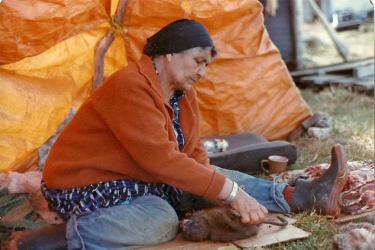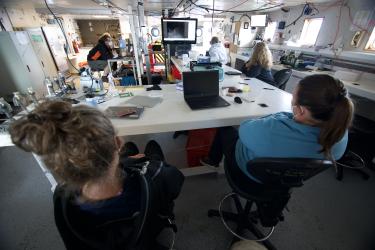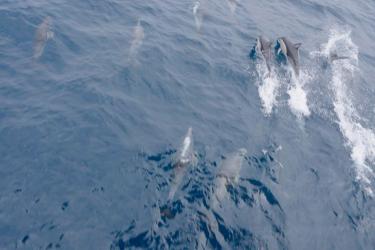
Manolo Castellote celebrating Del Westerholt’s arrival to the ADFG warehouse in Anchorage. Del is a master craftsman from Palmer, AK, building all our custom pieces to assemble instruments in the mooring packages. He arrived just in time to allow us to complete our mooring assembly a day before launching in the Upper Inlet. - Photo: Tom Gage, ADFG
The last few days have been spent building the subsurface moorings we’re going to deploy throughout the inlet. We say building instead of assembling because these things never seem to go together quite like we planned. So we have to customize everyone so they work the way we want them to. Luckily we’ve done this before. More on that in a moment.
Our mooring design is pretty straightforward. A specialized foam float keeps the scientific instruments (echolocation click detector – C-POD, Chelonia Ltd., underwater acoustic recorder – DSG-ST, Loggerhead Instruments, and a temperature/depth recorder – HOBO, Onset) suspended safely a few feet off the bottom of the Cook Inlet. This instrument package is attached to an acoustic release transponder (PORT, EdgeTech) linked to a noise reducing Vectran mooring line, which is in turn connected to a piece of train track that’s been repurposed as a glorified anchor.
During the last several months, we have been purchasing a myriad of parts and pieces for these moorings. Things like anchors, chain, line, and shackles can all be sourced locally in Anchorage at the time of our choosing, while specialized things like the Loggerhead, HOBO, and PORT are manufactured throughout the continental US. The C-PODs come from even further away- they’re made in England! Needless to say, all these expensive items needed to be ordered several months in advance, as well as setting up the contract to purchase them and still allow the manufacturer time to build and ship them for our fieldwork.

Hurricane Harvey takes aim at Houston Texas. - Image: Courtesy of NASA/NOAA – GOES project
Just when you think you’ve got all your ducks moorings in a row, Mother Nature steps in and reminds you who is actually in charge, an important lesson for all of us doing fieldwork. In our case, it was not one but TWO hurricanes that threatened to derail our project until 2018.
Our foam float vendor relocated to Houston, Texas just in time to get hit by Hurricane Harvey so their production ceased for a number of weeks and they only finished and shipped our order on the last day we could get them and still salvage our season. This was quite a feat!! They got the plant up and running, the custom floats made and shipped all while starting the recovery from Harvey, we cannot thank them enough!
Then the Loggerhead manufacturer located in Sarasota, Florida managed to just barely get our gear shipped out before Hurricane Irma slammed into the Sunshine State and wreaked havoc. We’re very fortunate to have manufacturing partners that go the extra mile to ship these pieces in time since a delay of a week may as well be a delay of 6 months because Alaskan fall turns to winter so quickly that we’d never be able to deploy them until ice is melted in the spring.

Justin Jenniges (ADF&G) attacking a couple of our older mooring packages to scavenge subsurface float blocks in case of further extended delays in receiving our new blocks out of the aftermath of hurricane Harvey. - Photo: Manolo Castellote
In the coming days, we will be deploying 11 acoustic moorings throughout Cook Inlet stretching from Goose Bay in the extreme upper Inlet all the way down to Chinitna Bay 230km to the southwest. These moorings will stay submerged under the muddy, ice-covered Inlet waters until spring 2018, patiently listening and recording what belugas have to say about their life in the Inlet in winter. As a bonus, we might be able to hear killer whales and harbor porpoises move through the Inlet as well.
For years, cetacean biologists have been debating whether belugas feed in winter, what type of prey is available, and how does all this affect the survival and recovery of this endangered population. So, one of the goals of the overwinter mooring deployments is to identify beluga wintering areas and document if foraging behavior occurs in any of the monitored locations.
When spring rolls around, we’ll return to the deployment site, use our hydrophone to give a shout out to the PORT and tell it to let go of that anchor so it can come join us at the surface. Naturally, as scientists, we keep our fingers crossed to ensure a successful recovery.
Additional Resources
Meet the Bloggers

Manuel Castellote
Manuel Castellote, NOAA affiliate, is a bioacoustician at the Alaska Fisheries Science Center’s Marine Mammal Laboratory. Manuel joined the Lab’s Cetacean Assessment and Ecology program in 2010 after completing his Ph.D. in Spain, where he studied the effects of shipping and seismic survey noise on fin whale singing behavior.

Mandy Keogh
Mandy Keogh earned her Ph.D. at the University of Alaska Fairbanks in 2011 following which she was a research Scientist at Mystic Aquarium and conducted research on belugas maintained at the aquarium as well as with the Bristol Bay beluga population. Mandy returned to Alaska as a Wildlife Physiologist with the Alaska Department of Fish and Game's Marine Mammal Program in 2015. Mandy's current research focuses on Steller sea lions, northern fur seals, and Cook Inlet belugas.

Justin Jenniges
Justin Jenniges is a Fish & Wildlife Technician with the Alaska Department of Fish & Game. He has been assisting Scientists from a variety of Federal, State, and Non-governmental organizations with west coast marine mammal research since 2002. His interests include eating bacon, watching television, and coloring books.
This project is part of two 3-year projects being conducted with annual funding by the NOAA Endangered Species Act Section 6 Program. Georgia Aquarium and John G. Shedd Aquarium have provided matching financial support and will develop education programs based on both projects. Department of Fish and Game marine mammal scientists will lead the research in collaboration with Alaska Fisheries Science Center Marine Mammal Laboratory, the University of Alaska Fairbanks, the University of Washington, Harbor Branch Oceanographic Institute at Florida Atlantic University, and the Cook Inlet Beluga Whale Photo-ID Project (at LGL Alaska Research Associates, Inc). Samples and data were also provided by the Marine Mammal Health and Stranding Response Program.



